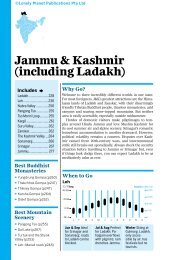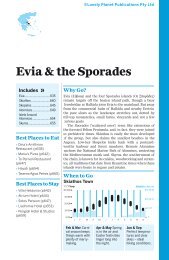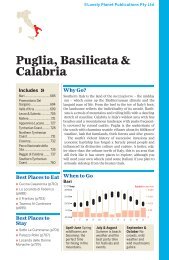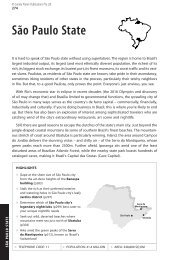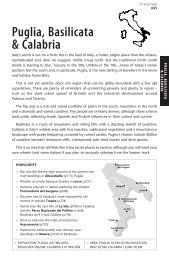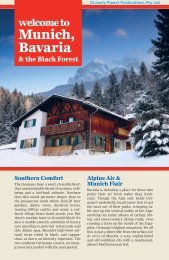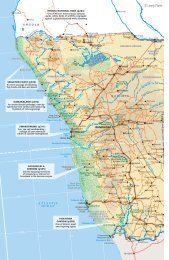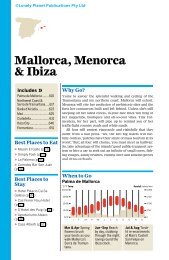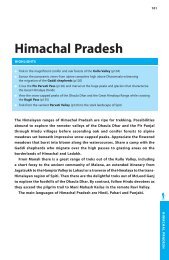Travelling - Lonely Planet
Travelling - Lonely Planet
Travelling - Lonely Planet
Create successful ePaper yourself
Turn your PDF publications into a flip-book with our unique Google optimized e-Paper software.
LONELY PLANET’S GUIDE TO<br />
TRAVEL<br />
PHOTOGRAPHY<br />
Richard I’Anson<br />
1
CONTENTS<br />
THE AUTHOR 5<br />
THIS BOOK 6<br />
FOREWORD 10<br />
INTRODUCTION<br />
A SHORT HISTORY OF TRAVEL<br />
13<br />
PHOTOGRAPHY 16<br />
01: GETTING<br />
STARTED 19<br />
DIGITAL PHOTOGRAPHY<br />
Sensors, Pixels &<br />
21<br />
Resolution 23<br />
Image Quality & File Size 30<br />
Aspect Ratio 30<br />
Memory Cards 31<br />
Firmware 33<br />
Digital Camera Features 33<br />
Colour & Creative Controls 37<br />
THE GEAR 40<br />
Cameras 41<br />
Lenses 50<br />
Accessories 58<br />
Bags<br />
Buying Guide for Digital<br />
68<br />
Cameras 69<br />
DSLR Systems 70<br />
FILM CAMERAS 72<br />
Camera Formats 72<br />
Camera Types 73<br />
Film 74<br />
OTHER IMAGING OPTIONS 80<br />
Camera Phones 80<br />
Video Cameras 83<br />
2<br />
COMPUTERS & SOFTWARE<br />
Digital Photography without<br />
93<br />
a Computer 93<br />
Computer Specifications 93<br />
Monitors 94<br />
Computer Accessories 95<br />
Software 96<br />
PREPARATION 99<br />
Research 100<br />
When To Go 100<br />
<strong>Travelling</strong> with Others 101<br />
Time 102<br />
Shot Lists<br />
Perfecting Your<br />
102<br />
Technique 103<br />
Equipment<br />
How Much Memory<br />
103<br />
Capacity to Take 106<br />
Workflow on the Road 109<br />
Insurance 110<br />
AT YOUR DESTINATION 111<br />
At Customs 111<br />
Where to Stay 112<br />
Familiarisation 112<br />
Vantage Points 114<br />
Fine-Tuning Plans 115<br />
Routine & Habits 115<br />
Photo Etiquette 117<br />
Restrictions 118<br />
Taking Notes 119<br />
Security<br />
Developing & Printing<br />
119<br />
Film 121<br />
Shipping Discs, Film & Prints 121<br />
Camera Care 122<br />
02: THE ART OF<br />
PHOTOGRAPHY 127<br />
MOMENTS IN TIME 129<br />
Previsualisation 130<br />
Being There 131<br />
Iconic Images 135<br />
Maximising the Moment 139<br />
Telling a Story 140<br />
EXPOSURE 143<br />
ISO Rating 143<br />
Shutter Speed 144<br />
Aperture<br />
ISO, Shutter Speed &<br />
145<br />
Aperture Combinations 145<br />
Measuring Light 146<br />
Exposure Modes 147<br />
Other Exposure Controls 148<br />
Setting Exposure 149<br />
COMPOSITION 157<br />
Point of Interest 158<br />
The Rule of Thirds 158<br />
Depth of Field 159<br />
Focus 160<br />
Choice of Lens 163<br />
Viewpoint 165<br />
Content Selection 168<br />
Framing 169<br />
Horizons 170<br />
Orientation 170<br />
Scale 171<br />
LIGHT 173<br />
Natural Light 174<br />
Sunrise & Sunset 177<br />
Rainbows 178
Flash 178<br />
Incandescent Light 182<br />
Mixed Light 184<br />
MOVING SUBJECTS 187<br />
Freezing the Action 187<br />
Panning & Blur 188<br />
From the Air 191<br />
Light Trails 194<br />
CAMERA PHONE IMAGES 196<br />
MAKING MOVIES<br />
Video Capture with Still<br />
200<br />
Cameras<br />
Video Capture with<br />
200<br />
Camcorders 201<br />
03: THE<br />
SUBJECTS 205<br />
PEOPLE<br />
Communication with<br />
207<br />
Strangers 208<br />
Portraits 210<br />
Environmental Portraits 212<br />
Groups 214<br />
Children 216<br />
Travel Companions 218<br />
Daily Life 220<br />
LANDSCAPES 223<br />
Mountains 226<br />
Snow, Ice & Glaciers 230<br />
Deserts 232<br />
The Coast 234<br />
Rainforests 236<br />
Rivers & Waterfalls 238<br />
Lakes & Reflections 240<br />
Flowers 242<br />
Natural Details 244<br />
THE URBAN ENVIRONMENT 247<br />
After Dark 249<br />
Interiors 250<br />
City Views 251<br />
Skylines 252<br />
Architecture 254<br />
Architectural Details 256<br />
Streetscapes 258<br />
Urban Details 260<br />
Street Art 262<br />
Galleries & Museums 264<br />
Places of Worship 266<br />
Traffic & Transport 268<br />
FESTIVALS 271<br />
Dealing with Crowds 272<br />
Parades & Processions 274<br />
ENTERTAINMENT 279<br />
Performance 280<br />
Shopping 282<br />
Sporting Events 284<br />
Nightlife 286<br />
FOOD & DRINK 289<br />
In the Field 290<br />
At the Market 292<br />
In the Kitchen 294<br />
On the Table 296<br />
WILDLIFE 299<br />
Zoos & Sanctuaries 302<br />
Up Close 304<br />
Habitat 306<br />
Birds 316<br />
Marine Life 320<br />
04: BACK<br />
AT HOME 323<br />
POST-CAPTURE WORKFLOW 325<br />
Transfer 326<br />
View, Select & Delete 327<br />
Add Metadata 327<br />
Archive 328<br />
Convert & Edit 328<br />
Output 334<br />
Backup<br />
Remove Image Files from<br />
335<br />
Computer Hard Drive 335<br />
AT HOME WITH FILM 336<br />
Assessing Slides 336<br />
Storing Film 337<br />
SHARING<br />
Choosing Photographs to<br />
338<br />
Share 338<br />
Printing Digital Images 339<br />
Slide Shows 344<br />
Emailing Photos<br />
Sharing Photos &<br />
345<br />
Videos Online 346<br />
Blogs 348<br />
SELLING TRAVEL IMAGES<br />
The Business of Travel<br />
350<br />
Photography 350<br />
Being a Travel Photographer 353<br />
GLOSSARY OF PHOTOGRAPHIC<br />
TERMS 361<br />
INDEX 366<br />
GEOGRAPHIC PHOTO INDEX 368<br />
3
THE AUTHOR<br />
Richard I’Anson is a freelance photographer who has built a career on his twin passions for travel and<br />
photography. Over the past 27 years he has travelled the world amassing a substantial and compelling<br />
collection of images of people and places in more than 70 countries on all seven continents.<br />
Richard received his first camera as a gift from his parents when he was 16 and has been infatuated with<br />
photography ever since. After studying photography, film and television for two years at Rusden State College<br />
in Melbourne, he worked in a camera store and minilab before going freelance in 1982.<br />
His work is published worldwide in books, magazines, newspapers, brochures, calendars, posters, cards<br />
and websites. He has published numerous books: Chasing Rickshaws (1998) and Rice Trails (2004), both<br />
collaborations with <strong>Lonely</strong> <strong>Planet</strong> co-founder Tony Wheeler; Travel Photography (2000, 2004 and 2009<br />
editions) and Urban Travel Photography (2006); and the large-format pictorials Australia: 42 Great Landscape<br />
Experiences (2006) and Nepal: Kathmandu Valley, Chitwan, Annapurna, Mustang, Everest (2007).<br />
Richard is a double Master of Photography with the Australian Institute of Professional Photography (AIPP)<br />
and was judged top travel photographer in Capture Magazine’s 2007 Australia’s Top Photographers Awards.<br />
<strong>Lonely</strong> <strong>Planet</strong> has been using Richard’s photographs for 18 years and his work has been featured in over 400<br />
editions of LP titles. When he’s not on the road Richard lives in Melbourne, Australia, where he makes regular<br />
appearances at <strong>Lonely</strong> <strong>Planet</strong>’s head office to assist in the ongoing development of <strong>Lonely</strong> <strong>Planet</strong> Images (www<br />
.lonelyplanetimages.com), the stock photography library he helped establish in 1998. To see more of Richard’s<br />
images log onto www.richardianson.com.<br />
FROM THE AUTHOR<br />
It’s a pleasure to be able to share what I’ve learned and seen in more than 25 years of shooting travel photographs.<br />
Thanks to the rapidly evolving developments in the world of digital photography, it’s a serious challenge for all<br />
of us involved in the imaging industry to keep up to date with equipment and software offerings. Writing this<br />
book gives me the opportunity to gather, assess and present a relevant snapshot of this information alongside<br />
the more creative and timeless elements of the art, subjects and practicalities of travel photography.<br />
It’s also a great opportunity to thank again the people who have played a significant part in my journey and<br />
contributed in various ways to my body of work from which I draw the contents of this book. Thanks then<br />
to Tony and Maureen Wheeler at <strong>Lonely</strong> <strong>Planet</strong>, Nick Kostos and Sue Badyari at World Expeditions, Peter<br />
Cocklin at Kodak Australia, the late Eddie Schreiber at Schreiber Photographics, Lothar Huber and Doug Porter<br />
at Bond Imaging, Canon Australia, Rick Slowgrove at Canon Professional Services and Rik Evans-Deane at<br />
Camera Action Camera House in Melbourne.<br />
At <strong>Lonely</strong> <strong>Planet</strong>, Ben Handicott, Ellie Cobb, Erin Richards, Michael Ruff, Jessica Rose, Ryan Evans, Gerard<br />
Walker and Tony Wheeler all made significant contributions to this edition.<br />
Thanks again to the team at <strong>Lonely</strong> <strong>Planet</strong> Images for their continuing interest and support of my work.<br />
At home, my thanks – as always – go to Iris, Alice and Sarah whose support, interest and understanding<br />
are so generously given and are greatly appreciated.<br />
On a personal note, producing this book has afforded me a unique opportunity to perform a substantial<br />
review of the images and practices that have got me this far. I see it very much as a celebration of passing<br />
the 25-year milestone as a photographer and traveller.<br />
5
THIS BOOK<br />
USING THIS BOOK<br />
Travel is an exciting experience and your photography should reflect that. Travel Photography introduces you<br />
to every aspect of the picture-taking process and the wide range of subject matter that you’ll encounter<br />
on your travels, to help you produce vibrant and meaningful images. It aims to increase the percentage<br />
of good photographs you take and to lift your travel photography to the next level of creativity. No matter<br />
where you’re going or what camera you use, you’ll find the information you need to make the most of the<br />
picture-taking situations that come your way. It will help you create photographic opportunities and to make<br />
your travel experience more photo friendly, with practical advice, tried-and-tested tips and inspirational<br />
images sure to get you thinking about both your photography and your next trip.<br />
With film cameras no longer being manufactured, every new camera these days is a digital model. Although<br />
film still has a loyal following, the book assumes readers will be travelling with a digital camera. And although<br />
there is a substantial amount of technical information, the heart of the book lies in the images. The advice<br />
and suggestions are just as applicable whether you capture your experiences on the pixels of a sensor or<br />
the silver halides of a film emulsion.<br />
Although the focus of the book is on capturing great still images on digital cameras, digital technology has<br />
opened up other possibilities for recording images. In the (not so) old days, you needed a camera for taking<br />
photos, a phone for making phone calls, an MP3 player for listening to music and a video camera for taking videos.<br />
Now you can do all of these things on one device. This is called technology convergence and it is leading to some<br />
truly exciting innovations. The most relevant examples to image-making are the camera phone, allowing both<br />
still and video images to be captured on a device made for making phone calls; video-capture mode on digital<br />
still cameras; and still-capture mode on video cameras. The introduction of video mode on digital cameras and<br />
mobile phones has introduced many people to the world of video-making for the first time. This book follows<br />
the convergence trend and offers advice about making photographs and videos with camera phones, digital<br />
cameras and video equipment.<br />
Part 1 will bring you up to speed with digital photography, discussing all your gear options and the many<br />
features and functions you need to know about to buy the right camera and get the most out of your gear<br />
(note that prices are given in US dollars throughout the book). It shows how research, planning and practice<br />
will enhance the experience of travelling with your camera. Part 2 looks at the art of photography and will<br />
give you the tools to create images that reflect your own vision of the world. Part 3 is an in-depth look at<br />
the subjects you’ll encounter, providing all the information you’ll need to successfully capture them, and is<br />
packed with inspirational images from around the world. Part 4 deals with photography post-trip, including<br />
digital workflow, image editing, sharing and selling your pictures, as well as an insight into the business of<br />
travel photography.<br />
This third edition of Travel Photography is also full of new images and insights from the road. Since the<br />
second edition was published in 2004 I’ve been to Nepal, India, China, Vanuatu, Brunei, Singapore, Malaysia,<br />
Thailand, Argentina, Antarctica, Russia, Mongolia, Finland, Slovenia, Romania, Croatia, England, France,<br />
6
Germany, Monaco, USA, Canada, Antigua, St Barts, Grenada, Barbados, Puerto Rico, St Martin, St Lucia,<br />
Egypt, Jordan and the United Arab Emirates, as well as to every Australian state.<br />
Even though this book is about travel photography, it could be said that all photography (outside the studio)<br />
is travel photography. One person’s backyard is another’s dream destination. Although this book is packed<br />
with images taken all over the world, you don’t have to have immediate plans for the ideas and techniques<br />
to be useful. You can put into practice much of what’s discussed here next time you photograph your family,<br />
your pets, go on a day trip and certainly on a holiday in your own country. In fact, I highly recommend that<br />
you do just that. Study the resulting photographs, and then go back out and take some more. You’ll learn a<br />
lot from your own successes and failures and reap the rewards in better photographs on your next trip to<br />
someone else’s backyard.<br />
THE AUTHOR’S APPROACH<br />
I’ve had the privilege of photographing all over the world and, most importantly from a creative perspective,<br />
had many opportunities to return to some countries three, four, 10 (China) and even more than 20 times<br />
(India and Nepal). And even after all these years, the thrill of arriving at my destination, dropping the bags<br />
at the hotel, grabbing the cameras and getting out there hasn’t waned. In fact, I enjoy it more now because<br />
I’m confident I’ll be able to capture the pictures I’ve come to take.<br />
Photographing travel for a living is an intense, exciting, tiring and thoroughly rewarding endeavour. I<br />
often walk 10km to 15km a day, shoot between 300 and 400 images and get very little sleep. But by the<br />
end of my trip I’ll have a comprehensive collection of images that capture a good cross-section of the<br />
places to see, things to do and people who live there. You can read more about my own travel photography<br />
practices on p350.<br />
The way I go about taking travel photographs has developed over the years and I am constantly<br />
assessing my methods and images in an attempt to make the results of each trip better than the last. To<br />
that end I now capture all my images digitally. I stuck with film longer than most, partly to complete longterm<br />
projects on the same media, but mainly until I was satisfied that the quality of the digital file was<br />
equivalent to what I was used to getting on film. Once that was achieved (with 21 MP DSLRs) the switch<br />
was easy thanks to a couple of digital imaging’s most useful features: at the capture stage, the flexibility<br />
of changing the ISO from frame to frame; and the ability to instantly review the shots. Seeing the pictures<br />
immediately is helpful when shooting but, just as importantly, it allows me to make accurate decisions<br />
regarding completion of a subject shoot. At the post-capture stage, it is far easier and considerably<br />
quicker to label large quantities of images and find them again when you need them, thanks to the latest<br />
generation of workflow software. Finally, although the digital workflow has pushed a lot of work back onto<br />
the photographer that was previously performed by photo labs and photo libraries, the gain in control over<br />
the entire imaging process, from capture to output, means the pictures will always be seen how they are<br />
intended to look.<br />
But that’s just the technical stuff. What hasn’t changed is my aim to capture the reality of a place (as I see it)<br />
through strong individual images that build on each other to create a comprehensive coverage of a destination or<br />
topic, so that viewers get a sense of what it’s like to be there. My own interpretation – my style – is expressed<br />
through choice of camera format, lens, aperture and shutter-speed combinations, what I choose to photograph,<br />
the composition I settle on, the light I photograph in and, finally, the images I choose to show.<br />
7
I take the same gear on every trip (except the video camera) and it consists of the following items:<br />
� � Canon EOS 1Ds MkIII DSLR camera body<br />
� � Canon EOS 5D MkII DSLR camera body<br />
� � Canon EF 24–70mm f2.8 L USM zoom lens<br />
� � Canon EF 70–200mm f2.8 L USM image stabiliser lens<br />
� � Canon 300mm f4 L USM image stabiliser lens<br />
� � Canon 1.4x teleconverter<br />
� � Canon Speedlite 430EX II<br />
� � Leica M8 digital rangefinder camera with 21mm f2.8 lens<br />
� � Hoya multicoated skylight 1B filters (permanently attached to all lenses for protection)<br />
� � Hoya circular polarising filter<br />
� � Gitzo G1228 carbon-fibre tripod with Fobar Superball head. (I photograph landscapes, cityscapes<br />
and interiors, where possible, on the tripod; everything else is hand-held.)<br />
� � Assorted 8 GB, 4 GB and 2 GB Compact Flash II and SD memory cards totalling 24 GB capacity<br />
8
� � Laptop computer with 15-inch screen loaded with Adobe Lightroom, an image-processing and<br />
management program<br />
� � Two 320 GB portable hard disks<br />
� � Memory card reader<br />
� � Sony HVR-A1P digital HD video camera<br />
� Crumpler 7 Million Dollar Home soft shoulder bag – holds everything bar the tripod and 300mm lens<br />
� � Crumpler Whickey and Cox backpack for carrying gear onto planes and when trekking.<br />
Day to day, I keep my gear as simple as possible but, to cover the range of subjects I know I’ll encounter<br />
and to work as fast and as efficiently as possible, I always carry the two DSLR cameras, one with a<br />
24–70mm lens and the other with a 70–200mm lens. I only carry the tripod, 300mm lens and flash unit<br />
when I know I’ll need them for specific shots. I use the Leica rangefinder camera in situations where I want<br />
to be a little more discreet, such as in galleries, museums, restaurants and bars, and when I’m ‘off duty’<br />
but can’t leave the hotel without a camera. It also serves as my back-up camera and usually stays locked<br />
up in the hotel room in case everything else is stolen. All images are captured in the raw file format. My<br />
default sensor sensitivity setting is ISO 100.<br />
PHOTO CAPTIONS<br />
This book contains images taken with the equipment listed above, and also images shot on various other<br />
cameras I’ve owned or loaned over the years, including both digital and film cameras.<br />
The photographs in Travel Photography are accompanied by both informative and technical captions that<br />
will help you learn about taking photographs in a variety of circumstances and give you an insight into many<br />
of the issues encountered when shooting on the road. Captions include the following information:<br />
� � Image title, location and country<br />
� � Camera type and lens<br />
� � File or film format<br />
� � Exposure (shutter speed, aperture and ISO)<br />
� � Any accessories used (tripod, filters and flash).<br />
Note that all focal lengths are given as 35mm equivalents (see p52).<br />
Author in tea estate, Kazaringa, India<br />
Photo by Doljit Pangging<br />
9
FOREWORD<br />
<strong>Lonely</strong> <strong>Planet</strong> Images – the <strong>Lonely</strong> <strong>Planet</strong> photo library – has more than a quarter of a million images from<br />
just about every country on earth in its collection. They’re waiting to be used in <strong>Lonely</strong> <strong>Planet</strong> books or in<br />
books by other publishers, by ad agencies, magazines, airlines, newspapers, websites or just about anybody<br />
else who needs a really knock-out travel photograph.<br />
And something like 1500 of those photographs are mine.<br />
Not because I’ve pulled any strings. Just because I was <strong>Lonely</strong> <strong>Planet</strong> employee number one – number<br />
two if my wife, Maureen, pulls rank on me – doesn’t get me any favours. (I’ve even written a whole book on<br />
travelling across the Pacific, only to have it rejected by our travel literature publisher – ‘not exciting enough’,<br />
she announced.)<br />
No, my travel photographs appear in our photo library because they’re good enough to have made the cut.<br />
Of course, the fact that I manage to get to some pretty unusual places helps. There’s less competition for<br />
photographs from, say, Saudi Arabia, Haiti or North Korea than from Italy, France or the USA. But, at the end<br />
of the day, they’re still going to have to be very good photographs.<br />
What’s in front of your lens may help things along, and high-quality camera equipment is a given, but it’s<br />
your skill – the quality of your photography – that is going to make all the difference. I reckon there are three<br />
secrets to getting those ‘wow factor’ photographs. First of all, take lots of photographs; there’s no substitute<br />
for experience and that means point your lens and exercise that finger on the shutter release. Secondly,<br />
there’s education, which can mean taking a photography course or reading a good book on photography,<br />
like the one in your hands right now. Thirdly, there’s no better way to find how to do it than to watch and<br />
study a real expert.<br />
I’ve been lucky enough to have several intensive experiences of that third element of a photographic<br />
education. I’ve travelled with Richard I’Anson to work on our books Chasing Rickshaws and Rice Trails and<br />
I’ve travelled with both incarnations of Richard: the film and the digital photographer. These days everybody,<br />
and that includes the experts, is having to revise their photographic skills as they make the shift from film to<br />
digital. The change has gone from a gradual trend to an all-but-total shift. Film has become an endangered<br />
species and, although the techniques and skills of film photography are still worth cultivating, today digital<br />
is what it’s all about.<br />
Of course, many aspects of photography are just as relevant to a film camera as a digital one.<br />
Composition, focus and exposure are all important skills which this book will help you master. Yet at<br />
the same time digital photography has brought new conveniences, opportunities and, just as important,<br />
unexpected new challenges.<br />
10
Sometimes travelling with Richard simply confirms that those old photographic clichés are true: the light<br />
really is better at dawn, otherwise why would I have suffered so many predawn wake-up calls when I’m in<br />
Richard’s company?<br />
I’ve also been horrified by how much camera equipment Richard seems to carry around, and moving into the<br />
digital world doesn’t necessarily make that load any lighter. You may not have to carry all that film (or worry<br />
about keeping it cool, out of the sun and away from X-ray machines), but your bag is going to be heavier by<br />
a laptop or some other digital storage medium and you’ll soon find that your remaining gigabytes of storage<br />
capacity will be just as big a worry as how many frames of film you had left.<br />
My first digital trip with Richard, a little coast-to-coast two-week trek across England from the Irish Sea<br />
to the North Sea, brought those changes home, along with the necessity of always heading out, waiting for<br />
that unexpected opportunity to pop up. The longest and dullest day of the walk also happened to be the day<br />
with the worst weather. Yorkshire weather. Our fellow walkers all decided this was the day to take the bus;<br />
Richard and I walked on, through a thunderstorm. Richard because there always might be a photograph out<br />
there. And me? Because I’m crazy, I guess.<br />
No matter how good your equipment and how skilled the practitioner, successful travel photography can come<br />
down to sheer luck. Or sheer perseverance. Sometimes you simply have to tough it out in search of the perfect<br />
photo. On one trip to Nepal our search for rice terraces with snow-capped mountains in the background had<br />
been thwarted by day after day of nonstop rain. Finally the sun broke through just hours before our departure.<br />
We diverted our airport-bound taxi to the edge of the Kathmandu Valley and sprinted up a hill to find, on the other<br />
side, the perfect view – rice fields being harvested, picturesque houses in the foreground, soaring Himalayan<br />
peaks as a backdrop. And a river separating us from the picture. We tore off our shoes, rolled up our trousers,<br />
waded across the river, got the photographs, interrogated the farmers, and still made it to the airport in time for<br />
our flight – a little damp and rather muddy, but with the images we needed.<br />
On another Nepal visit I staggered to the top of Kala Pattar, the Everest viewpoint overlooking Everest<br />
Base Camp. Richard was already there, wedged against a rock, hanging on in a wind fierce enough to<br />
strip the Gore-Tex off your back and the camera out of your hand. I soon decided to head back down to<br />
my tent, leaving Richard to look for that perfect sunset shot of the world’s highest peak. Perseverance<br />
won out; he got it.<br />
Equipment, expertise, luck and straightforward hard work are all only parts of the photographic story. It’s<br />
travel which takes us out there and puts those amazing images, whether of people, places, nature or scenery,<br />
in front of our cameras.<br />
TONY WHEELER<br />
FOUNDER, LONELY PLANET<br />
11
INTRODUCTION<br />
It’s freezing outside. Actually, it’s freezing inside as well, but I don’t care. Today I achieved something I<br />
first attempted in 1989: to travel in Arunachal Pradesh, in India’s northeast. Twenty-odd years ago it took<br />
nearly five weeks in Kolkata to reach the conclusion that a permit was not going to be issued. Even today,<br />
travelling individually is technically not allowed. This time, with three months’ notice, the permit was only<br />
faxed from the travel agent in Delhi the evening before my planned departure; talk about cutting it fine.<br />
Yesterday I left a place called Dirang, crossed the 14,000ft Sela Pass, and reached my destination, Tawang<br />
Gompa. For the traveller it’s got everything: a magical-sounding name, a degree of difficulty that puts most<br />
people off going and an awesome mountain location close to the Bhutanese and Tibetan borders. It is, in<br />
fact, a very special place, being the second-largest Buddhist complex in the world after the Potala Palace in<br />
Lhasa, and home to around 400 monks. For me, it also completes my journey of experiencing the Himalaya<br />
from east to west. Today my twin passions of travel and photography are again as one.<br />
I’m often asked what came first, travel or photography? It’s hard to say: the first photograph I ever took<br />
was a travel photo. I was in the Canary Isles, I’d ridden from the port to the town in a horse-drawn cart, and<br />
when the driver had been paid I took a shot of him and his cart and my family – I was 10 and on my first big<br />
overseas trip, sailing from England to Australia. I remember the moment as though it were yesterday; the<br />
foreign sounds, language and smells; the click of the shutter. It must have made a deep impression. Six years<br />
later I got my first camera. My first thought was where can I go to take pictures? Seventy-odd countries,<br />
seven continents, hundreds of thousands, maybe millions of pictures later, and the list of places to see is still<br />
longer than the places I’ve been. Travel is like that; it’s addictive. So is photography. Combine the two and<br />
you have a lifetime of restlessness where the next trip is planned before the one you’re on is finished, time<br />
and money permitting. I solved the financial problem by turning my passions into my work, but I’m certainly<br />
not alone in wanting to capture and share what I see when I travel.<br />
In over 25 years of travelling I can count on one hand the number of people I’ve met who deliberately left<br />
home without a camera. <strong>Travelling</strong> provides a natural stimulus to picture-taking and even those who aren’t<br />
‘into’ photography display a strong, instinctive urge to record new places, new faces and new experiences.<br />
For some, travel photography is simply a record of a trip. For others, it’s a chance to release their creative<br />
side. Photo enthusiasts revel in the never-ending opportunities to take pictures that normally have to be<br />
planned and fit into regular life back home. For the professional travel photographer, it’s work. But for<br />
everyone, travel photography is about memories, experiences, engaging with new people and places, and<br />
sharing the journey with others.<br />
At its most basic, travel photography provides a visual record of the places visited. At its best it gives an<br />
insight into the world at large in all its diversity, adding something new to our understanding of a place and<br />
the people who live there. It portrays familiar places in unique ways, reveals lesser-known places with equal<br />
import, captures the spirit of the people with dignity and encapsulates unique moments in time that surprise,<br />
inform and intrigue viewers. It’s the counter to the incessant reporting and news footage that focuses on the<br />
negatives of people and places. Ultimately, it inspires in others a desire to see the world for themselves, and<br />
to take their own photographs along the way.<br />
Prayer wheels, Tawang, India<br />
DSLR, 24-70mm lens at 54mm, 1/100 f13, raw, ISO 100<br />
13
Thanks to the surge in popularity of digital cameras over the last four years and the consequent elimination<br />
of developing and printing costs, more pictures are being taken by more people than ever before. (That’s<br />
more pictures, not better pictures!) The idea that creating good photographs is simply a numbers game is<br />
as misguided as the camera manufacturers’ claims that by using their latest camera anyone can instantly<br />
produce professional-quality images. Without doubt, digital photographic technology has captured the<br />
public’s imagination and rejuvenated many people’s interest in photography, but it certainly hasn’t made<br />
people better photographers.<br />
Digital capture is still new to many people and there’s a steep learning curve that comes with the new<br />
technology. Consequently, and quite understandably, a lot of emphasis is being placed on the equipment,<br />
rather than the image. Modern cameras certainly give the impression that taking pictures is easier than ever<br />
before with the emphasis on automatic features that take care of everything, but people can still be left<br />
disappointed with their photos.<br />
If you want to avoid disappointment and elevate your pictures from simple snaps of your travels to the next<br />
level of quality and individuality, you need to understand the elements that go into creating good photographs.<br />
Then you can begin to take control of the picture-taking process.<br />
Automatic features are brilliant if you know what they are doing and the impact they are having on the<br />
image, so that you can decide if that is really how you want your photo to look. Exposure, for example, is often<br />
seen as a technical problem that the camera can solve automatically. And yes it can, in terms of exposing<br />
the sensor to the right amount of light. However, the variables that go into attaining ‘correct’ exposure (ISO,<br />
shutter speed and aperture settings) should actually be regarded as creative elements, as the combination<br />
selected can dramatically affect the look of the image; this is why professional photographers decide these<br />
things for themselves. In fact, every decision you make should be thought of as a creative decision, including<br />
your choice of camera and lens, exposure settings, whether or not you use a flash or tripod, the position<br />
from where you take the photo and the time of day you release the shutter.<br />
I hope that when you hit the road, Travel Photography inspires you to see and think creatively and to bring<br />
back images that best reflect your personal response to the people and places you visit.<br />
Enjoy the journey.<br />
RICHARD I’ANSON<br />
TAWANG, ARUNACHAL PRADESH, INDIA<br />
14<br />
Novice monks in lessons, Tawang Gompa, Tawang, India<br />
DSLR, 24-70mm lens at 28mm, 1/50 f2.8, raw, ISO 1000
A SHORT HISTORY OF TRAVEL PHOTOGRAPHY<br />
15




